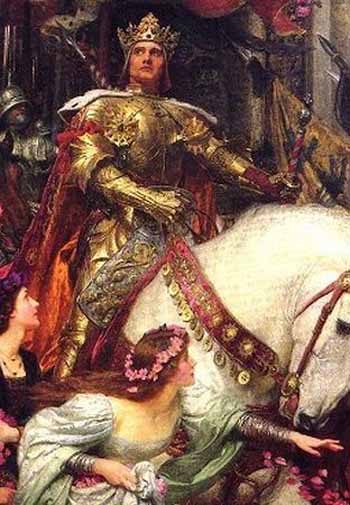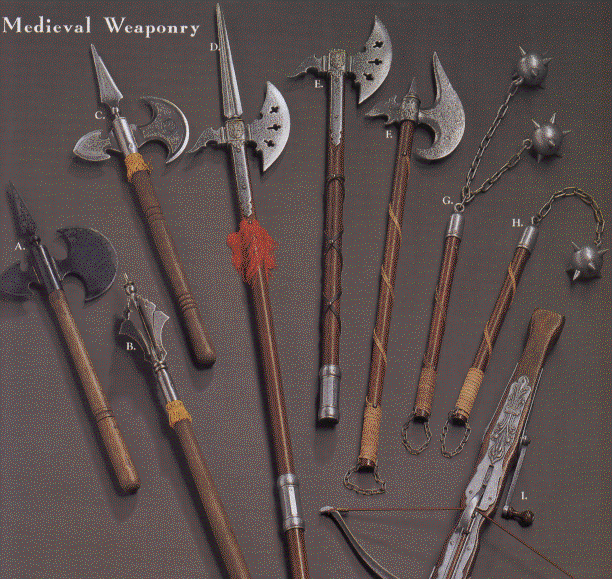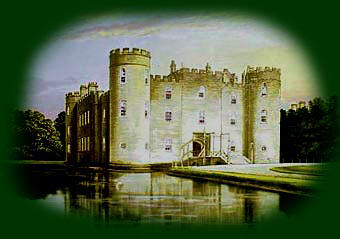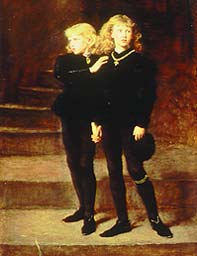http://www.middle-ages.org.uk/king-henry-vi.htm
The following biography information provides basic facts and information about the life of King Henry VI King of England:
Nationality: English
Also Known as: Henry of Windsor
Lifespan: 1421 – 1471
Reigned as King of England: Aug 31,1422 - March 4, 1461 and October 31,1470 - April 14, 1471. His coronation was on November 6, 1429
He was proclaimed King of France at Notre Dame in Paris on December 16, 1431
Date of Birth: King Henry VI was born on December 6, 1421 at Windsor Castle
Family connections / Genealogy: He was the son of King Henry V (1387-1422) and Catherine of Valois (1401-1437)
-
Children: Edward, Prince of Wales (1453-1471)
Date when King Henry VI died: May 22, 1471 at the Tower of London. He was buried at Windsor Castle
Cause of the Death of King Henry VI: King Henry was imprisoned in the Tower. The cause of his death is unknown
Character of King Henry VI: Gentle, pious, meek and obedient - given to fits of madness
Accomplishments or why King Henry VI was famous: The end of the Hundred Years War between England and France and the influence of Joan of Arc. The rising led by Jack Cade. The start of the Wars of the Roses (1455 - 1485)
King Henry VI
The story and biography of King Henry VI which contains interesting information, facts & the history about the life of King Henry VI
The story of King Henry VI ( AKA : Henry of Windsor )
Henry VI., was only nine months old when he was proclaimed King of France and England. The crown of England was held over his head, and his lords made their oaths to him: and when he was nine years old he was sent to Paris, and there crowned King of France. The war in France went on. The English were besieging Orleans, when a young village girl, named Joan of Arc, came to King Charles and told him that she had had a commission from Heaven to save Orleans, and to lead him to Rheims, where French kings were always crowned. When brought into the presence of Charles, whom she had never before seen, she recognized him, although he was dressed plainly, and one of the courtiers had on the royal apparel. She never let anything wrong be done in her sight--no bad words spoken, no savage deeds done; and she never fought herself, only led the French soldiers. The English thought her a witch, but the French common men were always brave with her to lead them. Joan of Arc saved Orleans, and brought the king to be crowned at Rheims. Joan of Arc was captured by the English who sentenced her to be burnt to death in the market place at Rouen as a witch, and her own king never tried to save her. The French went on winning back more and more; and there were so many quarrels among the English that they had little chance of keeping anything.
King Henry V married Margaret of Anjou, the daughter of a French prince, who had a right to a great part of the lands the English held. All these were given back to her father, infuriating the Duke of Gloucester. The English hated the young queen. She was as bold and high-spirited as the king was gentle and meek. He loved nothing so well as praying, praising God, and reading; and he did one great thing for the country--which did more for it than all the fighting kings had done, he founded Eton College, close to Windsor Castle; and there many of our best clergymen, and soldiers, and statesmen, have had their education.
The queen, Margaret of Anjou, was eagerly taking part in plots and quarrels, and the nation hated her the more for interfering. Humfrey, Duke of Gloucester, was, at the meeting of Parliament, accused of high treason and sent to prison, where, in a few days, he was found dead in his bed. These were very bad times. There was a rising under a man named Jack Cade, who held London for two or three days before he was put down; and, almost at the same time, the queen's first English friend, Suffolk, was exiled by her enemies, and taken at sea and murdered by some sailors.
The last of the brave old friends of Henry V. was killed in France, while trying to save the remains of the old duchy of Aquitaine, which had belonged to the English kings ever since Henry II. married Queen Eleanor. That was the end of the hundred years' war, for peace was made at last, and England kept nothing in France but the one city of Calais.
Still things were growing worse. Duke Humfrey left no children, and as time went on and the king had none, the question was who should reign. If the Beauforts were to be counted as princes, they came next; but everyone hated them, so that people recollected that Henry IV. had thrust aside the young Edmund Mortimer, grandson to Lionel, who had been next eldest to the Black Prince. Edmund was dead, but his sister Anne had married a son of the Duke of York, youngest son of Edward III.; and her son Richard, Duke of York, could not help feeling that he had a much better right to be king than any Beaufort. There was a great English noble named Richard Neville, Earl of Warwick, who liked to manage everything--just the sort of baron that was always mischievous at home, if not fighting in France--and he took up York's cause hotly. York's friends used to wear white roses, Beaufort's friends red roses, and the two parties kept on getting more bitter; but as no one wished any ill to gentle King Henry, who, to make matters worse, sometimes had fits of madness, like his poor grandfather in France, they would hardly have fought it in his lifetime, if he had not at last had a little son, who was born while he was so mad that he did not know of it.
Then, when York found it was of no use to wait, he began to make war, backed up by Warwick, and, after much fighting, they made the king prisoner, and forced him to make an agreement that he should reign as long as he lived, but that after that Richard of York should be king, and his son Edward be only Duke of Lancaster.
This made the queen, Margaret of Anjou, furiously angry. She would not give up her son's rights, and she gathered a great army, with which she came suddenly on the Duke of York near Wakefield, and destroyed nearly his whole army. He was killed in the battle; and his second son, Edmund, was met on Wakefield bridge and stabbed by Lord Clifford; and Margaret had their heads set up over the gates of York, while she went on to London to free her husband.
Edward, York's eldest son, was a better captain than he, and far fiercer and more cruel. He made the war much more savage than it had been before; and after beating the queen's friends at Mortimer's Cross, he hurried on to London, where the people, who had always been very fond of his father, and hated Queen Margaret, greeted him gladly. He was handsome and stately looking; and though he was really cruel when offended, had easy, good-natured manners, and everyone in London was delighted to receive him and own him as king. He became King Edward IV of England.
But Henry and Margaret were in the north with many friends, and he followed them to Towton Moor, where, in a snow storm, began the most cruel and savage battle of all the war. Edward gained the victory, and nobody was spared, or made prisoner - all were killed who could not flee. Poor Henry was hidden among his friends, and Margaret went to seek help in Scotland and abroad, taking her son with her. Once she brought another army and fought at Hexham, but she was beaten again; and before long King Henry was discovered by his enemies, carried to London, and shut up a prisoner in the Tower. His reign is reckoned to have ended in 1461.
Henry VI was briefly restored to power in 1470. King Henry VI was again imprisoned in the Tower of London where he died. The cause of his death is unknown. His son, Edward, was taken prisoner by Richard, Duke of Gloucester and brought before King Edward IV. When the young Edward insulted the Yorkist king, Edward IV ordered his immediate murder. He is buried at Tewkesbury Abbey.





 T
T

 The child lies unborn in the queen's womb;
The child lies unborn in the queen's womb; The eyes of the queen Morgause were a dark cavern;
The eyes of the queen Morgause were a dark cavern;